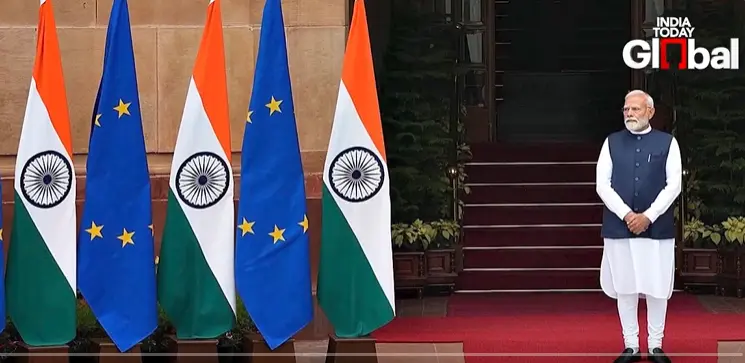
Modi’s EU outreach boosts India-EU FTA hopes as Trump’s tariff threats loom
Modi’s Trade Diplomacy Shakes Europe: Will Tariff Tensions Rise Again? – The key meetings between Indian and European Union leaders regarding the India-EU Free Trade Agreement (FTA) took place on September 12–13, 2025, in New Delhi. During this visit, European Trade Commissioner Maroš Šefčovič and Agriculture & Food Commissioner Christophe Hansen met with India’s Commerce Minister Piyush Goyal to advance negotiations and reaffirm their shared commitment to concluding the FTA by the end of the year.
Additionally, Prime Minister Modi held a phone conversation with Italian Prime Minister Giorgia Meloni on September 10, 2025, where they discussed the FTA and Italy’s proactive support for its conclusion.
A Stir in Europe: Modi’s Bold Push for India-EU Trade Deal
Prime Minister Narendra Modi’s recent diplomatic outreach in Europe has created waves across the continent. His strong pitch for the long-pending India-European Union Free Trade Agreement (FTA) has reignited discussions in Brussels, Berlin, and Paris. The deal, which has been under negotiation for over a decade, could open up smoother trade routes, reduce tariffs, and boost cooperation between India and 27 EU nations.
Modi’s meetings with top EU leaders were marked by urgency and optimism. He emphasized India’s growing role in global supply chains, its digital economy, and its commitment to clean energy. The EU responded positively, with several member states expressing support for finalizing the FTA by the end of the year.
However, this diplomatic momentum comes at a time when global tariff tensions are rising, especially due to recent remarks by U.S. President Donald Trump.
Trump’s Warning: Will Europe Target India Over Russian Oil?
President Trump has publicly criticized countries that continue to import oil from Russia, including India. He has called for steep tariffs up to 100% on Indian and Chinese goods, urging European allies to follow suit. His comments have sparked concern in diplomatic circles, especially as India balances its energy needs with global expectations.
So far, no European country has officially supported Trump’s tariff proposal. In fact, most EU nations are focused on economic recovery, climate goals, and strengthening ties with India. Germany, France, and the Netherlands have all signalled that they prefer dialogue over confrontation.
Still, Trump’s remarks have added pressure to the situation. If the U.S. imposes new tariffs on Indian goods, and if Europe follows, it could hurt India’s exports in sectors like textiles, pharmaceuticals, and electronics. For now, the EU seems committed to constructive engagement, not economic punishment.
The Six Key EU Players: Allies or Future Adversaries?
Six European countries hold major influence over the India-EU trade talks: Germany, France, Italy, Spain, Netherlands, and Belgium. These nations are India’s top trading partners in the EU and have strong diplomatic ties.
Let’s look at their current positions:
- Germany: Supports the FTA and sees India as a key partner in green tech and manufacturing.
- France: Focused on strategic cooperation, especially in defense and space; unlikely to back tariffs.
- Italy: Interested in boosting exports and tourism; prefers trade deals over trade wars.
- Spain: Prioritizes energy security and climate partnerships; neutral on tariff threats.
- Netherlands: Strong advocate for open markets; supports India’s digital economy.
- Belgium: As the EU’s administrative hub, plays a procedural role in shaping agreements.
| Country | Position on Tariffs | Role in FTA Talks |
| Germany | Supports FTA, cautious on tariffs | Strong backer of India-EU deal |
| France | Focused on strategic ties | Likely to resist broad tariffs |
| Netherlands | Trade-focused, wary of disruption | Supports balanced deal |
| Italy | Open to dialogue, not confrontation | Engaged in FTA chapters |
| Spain | Prioritizes energy security | Neutral stance on tariffs |
| Belgium | EU HQ, procedural influence | Key in shaping final agreement |
None of these countries have shown signs of “attacking” India with tariffs. Instead, they are working to finalize the FTA, which could benefit both sides through reduced duties, better market access, and stronger investment flows.
What’s Next: Trade Talks, Tariff Risks, and India’s Strategy
India is walking a tightrope. On one hand, it wants to secure favorable trade deals with the EU and other partners. On the other, it must manage its energy imports, especially from Russia, without triggering global backlash.
Modi’s strategy is clear: engage, negotiate, and diversify. India is expanding its energy sources, investing in renewables, and strengthening ties with countries like Norway and the UAE. At the same time, it’s pushing for trade deals that protect its interests and open new opportunities.
The coming months will be crucial. If the India-EU FTA is signed, it could be a major win for Modi’s foreign policy. But if Trump’s tariff threats gain traction, India may need to respond with its own trade measures or seek WTO intervention.
For now, the mood in Europe is cautious but hopeful. Modi’s “stir” has brought India back to the centre of global trade talks and the world is watching closely.
Final Thought: Trade Diplomacy Shakes Europe
In a world of shifting alliances and rising trade tensions, diplomacy matters more than ever. Modi’s push for the India-EU FTA is a bold move, and while Trump’s tariff threats loom, Europe seems more interested in building bridges than burning them.
Stay informed with the latest news and updates – only on Rapido Updates.